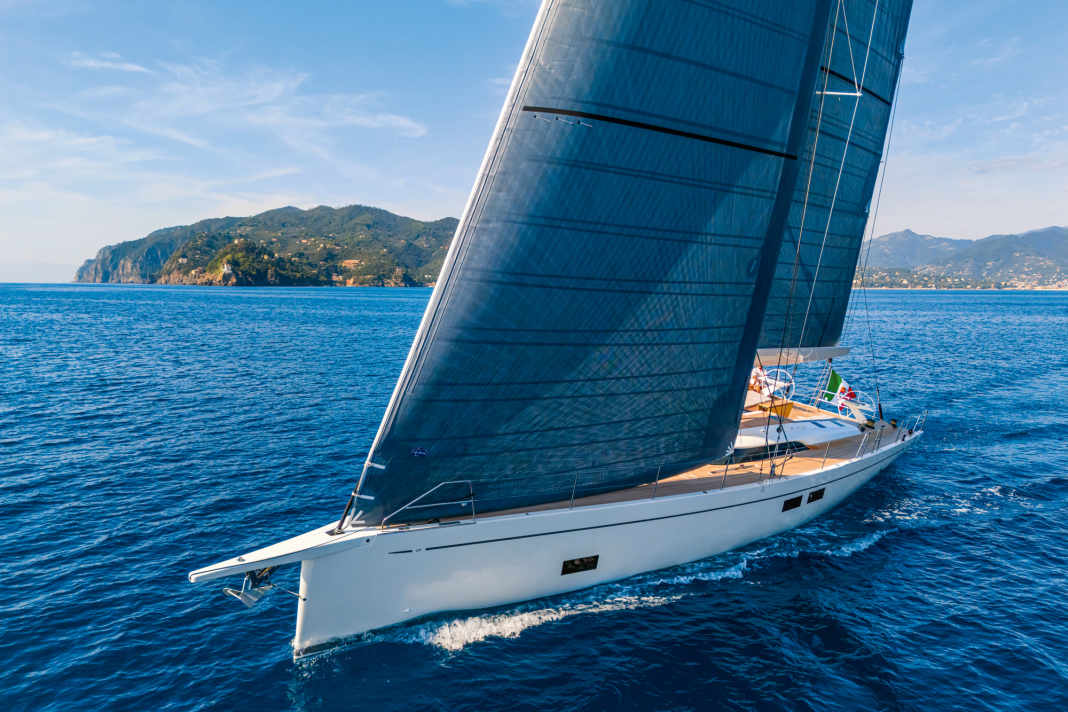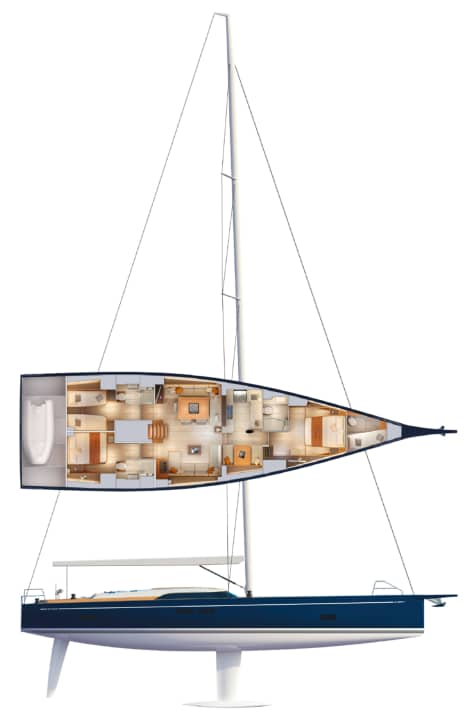





What could be nicer than walking barefoot across a sun-warmed teak deck? And what could be more unpleasant than banging your toes against the sharp edges of a deck fitting? Fortunately, this can hardly happen on a yacht like the Grand Soleil 65. There are almost no fittings on deck, and if there are, they are recessed or at least covered. After all, this is what the attractive yachts from Cantiere del Pardo's upmarket luxury programme are known and respected for: unobstructed areas, sheer layouts, sleek elegance.
In recent years, the yacht builders based in Forlì on the Italian Adriatic coast have driven forward the development of new yachts with almost unprecedented dynamism, particularly in the large and luxurious 60 to 80-foot hull length segment. Only recently, the Grand Soleil 72 has been completed (YACHT issue 13/2024). Now the next expansion step is already underway with the slightly smaller 65. A new Grand Soleil 60 is also already under construction and is scheduled for completion in 2025. The flagship of the range, the Grand Soleil 80, towers above everything else, although it is to be seen as a purely custom project with no proven ambitions for series production.
More from the shipyard:
But Cantiere del Pardo is also busy developing lines in the small length segment. Just recently, the busy Italians presented the Grand Soleil Blue, a small daysailer with a hull length of ten metres. The first boat is now also under construction. And a 40-metre boat has only been on the market for just under two years. Seen in this light: Hardly any other brand covers such a broad spectrum as Grand Soleil. The entire shipyard line currently has no fewer than 14 models between 33 and 80 feet in length, the oldest of which has been on the market for less than ten years.
In order to maintain an overview, Cantiere del Pardo intends to market the upmarket programme from 60 feet hull length upwards as an independent line within the shipyard programme under the name Grand Soleil Plus. To this end, the Grand Soleil 65 and 72 types are each available in two versions, LC (Long Cruise) and Performance. The difference between the two versions lies primarily in the design of the cabin superstructure and therefore also in the interior fittings.
No concrete price list due to high individuality
The yacht presented here is the 65 in the LC version, i.e. with a slightly raised cabin superstructure and an all-round window strip. This allows the shipyard to plan the interior with a saloon that is also raised, giving even more options for a customised layout below deck. In the Performance version, on the other hand, the cabin superstructure is ultra-flat and the windows are reduced to narrow slits. The entire interior also remains at a continuous level, without steps and landings as in the LC version.
However, the hull, the hull appendages and the cockpit design are the same in both versions, as is the general layout on deck. The shipyard also makes no distinction in terms of equipment, whether Long Cruise or Performance. In any case, the customer has the say in this regard and can have their yacht customised entirely according to their personal wishes as part of a genuine semi-custom project. "We can fulfil all customer wishes as long as they are technically feasible and can be reasonably implemented in terms of design," says Franco Corazza, who is responsible for developments in the high-end luxury segment at Grand Soleil.
As a result of this high degree of individuality, Cantiere del Pardo does not maintain standard specifications or a concrete price list for the large yachts in the range. When pressed, Franco Corazza merely gives us an approximate price classification for the 65 LC, which is available to us for an extended trial run off Palma de Mallorca. The very high-quality construction number two, equipped with almost all optional extras, is said to have gone to its proud owner for around 2.8 million euros net.
Concept for Mediterranean use
This also includes the beautifully crafted carbon fibre rig from Axxon Composites with rod shrouds and the Park Avenue main boom, also made of carbon. There is also a very extensive sail wardrobe with the best laminate material for the Amwind sails. Buyers can decide for themselves whether they want to operate the boat with an overlapping genoa or with a self-tacking jib. As the mast is positioned comparatively far aft, both variants are sufficiently large, even for presumably less windy areas.
The concept even focusses on Mediterranean use. This is particularly evident in the cockpit design. The spacious and mostly unobstructed arrangement offers plenty of room to move for the working crew and guests on board. This is great for relaxing stays in a quiet bay, in the harbour or in lovely wind conditions underway. However, the open and sheer cockpit design also has disadvantages in windy, heeling and swelly conditions. If you have to move around in the cockpit or on deck, you will be looking in vain for a solid stance and good holding options.
Although the long and extremely wide thwarts with a seat depth of around one metre make for nice and comfortable sun loungers, they are also cramped when underway because you can neither lean against the coaming nor support yourself properly with your feet. This compromise clearly prioritises the boat as an exquisite platform for pleasure sailing, but also overlooks the requirements for use on the high seas in the sense of LC - Long Cruise.
Sailing potential is remarkable
The halyards as well as the trim and reefing lines on the Grand Soleil 65 LC remain in the mast area and are operated via two electric winches mounted on deck. In this way, the shipyard wants to avoid a lot of sheets being led into the cockpit and lying around there. Therefore, only the sheets for the genoa and mainsail as well as for additional space windsails such as code zero or gennaker are operated in the working area at the very back. Hydraulic tensioners trim the backstay and the boom vang.
The sailing potential of the Grand Soleil 65 LC is remarkable. In very constant wind conditions of around 16 to 20 knots, the 20 metre long construction from the pen of ORC artist Matteo Polli easily achieves speeds of over 8.5 knots at a tacking angle of 90 degrees. On the way back under gennaker, the log remains in the double-digit range at all times and can even reach 14 knots in the gusts. Even for a large vessel of this orientation, these are impressive performance figures.
At the shipyard in Forlì, the hulls and decks are built as a GRP sandwich construction with a foam core and vinyl ester resin using the vacuum infusion process. The floor assembly is produced monolithically, also using vacuum infusion, and glued into the hull and additionally laminated. The structures in the keel area and on the rudder shaft are reinforced with carbon fibre layers in areas subject to high loads. The shrouds are not bolted to stainless steel plates, but solid composite fittings are firmly laminated into the hull structures. This results in unusually rigid and solid connections, and many possible noise bridges can also be suppressed.
Dolce Vita without restrictions
In fact, it is unusually quiet and very cosy below deck, both under sail and in the harbour. There is hardly anything to be heard from the waves underway, only a quiet purring can be heard from the large 175 hp built-in engine, and even when the crew on deck are tinkering with the winches, it remains surprisingly quiet inside. It is as if you were far away from the action on deck. The yachts from Cantiere del Pardo have always scored highly with their good, solid workmanship and build quality. The design is flawless and harmonious down to the smallest detail. This is particularly true of the luxury class boats. The very robust joinery work, which is handcrafted with a high proportion of solid wood, is particularly pleasing.
Grand Soleil has long since established a solid and relevant market position in the XXL yacht segment. The Italians do not need to shy away from comparisons with the exclusive competition from Solaris Yachts or Nautor's Swan, for example, neither in terms of quality, appearance nor sailing characteristics.
Technical data of the Grand Soleil 65 LC

- Torso length: 20,10 m
- Waterline length: 18,20 m
- Width: 5,95 m
- Depth: 3,50 m
- Weight: 27,5 t
- Sail area on the wind: 260,0 m2
- Machine (Yanmar, shaft drive): 175 HP
- Shipyard: Cantiere del Pardo/Grand Soleil
- Distribution: Diamond Yachts, Laboe

